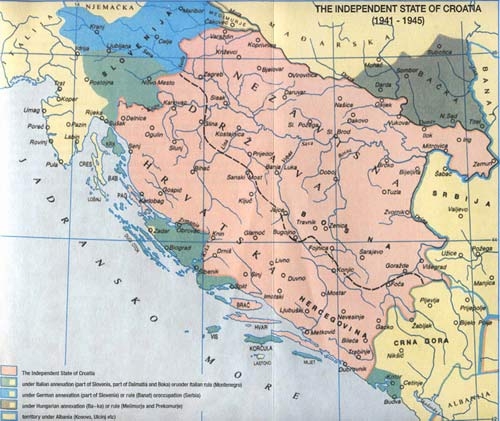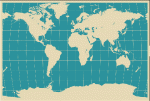Web catalog
Most read
Most read last 7 days
Most Discussed
Top rated
Statistics
- Total registered users: 10041
- Total articles: 23656
- Total comments: 2087
- Last entry: Kebo presenting evidence that Izetbegovic brought mujahideen to Bosnia
- Last update: 11.01.2019. 23:44
World War 2: Heart of Darkness (1941 - 1945)

6th April 1941
The attack of the Third Reich and Italy on the Kingdom of Yugoslavia began. Yugoslavia capitulated on the 17th April, in less than two weeks.
1941 -1945
The World War II on the territory of Yugoslavia, divided in German and Italian spheres of influence(with Hungarian and Bulgarian "co-occupiers").
During the war the main opposing forces were:
- occupying Fascist formations, strengthened with "domestic" forces (Croatian and Muslim on the territory of the puppet NDH, which included Croatia and Bosnia and Hercegovina; Serbian Fascists in Serbia and Albanians on Kosovo).
- Serbian Chetniks, their stronghold in Serbia and the parts of NDH with Serbian population, with the nominal aim of re-establishment of the Kingdom of Yugoslavia, as well as with the practice and programme of pogrom and genocide over Croats, Bosnian Muslims and Albanians
- the forces of the Communist Party of Yugoslavia with the programme of establishment of Yugoslavia as the federal state consisting of national republics (except Bosnia and Hercegovina, wich was designed as the three nations state),and with the social revolution based on the Soviet Stalinist model. Partisans (how the Communists soon came to be known ) became the most active fighters against German and Italian formations and their allies.
The war can generally be divided in 3 phases:
- in the 1st period Communists and negligible part of Chetniks rose up en masse in arms rebellion against the occupying forces in Serbia and Montenegro. The uprising was completely broken down till the end of 1941.
- in the 2nd period, which lasted till the approach of the Soviet Army close to the Yugoslav frontiers in the middle of 1944, the Partisan forces led mostly exhausting guerilla warfare on the territory of Croatia and Bosnia and Hercegovina. The main enemies are, except German and Italian units, military formations of NDH and the Chetniks of Draza Mihailovic.
- in the 3rd period, supported by the Soviet Army, Tito's Yugoslav Army led final operations to destroy the opponent forces and achieved complete control over the Yugoslav territory. At the end of the war, wich itself was bloody, Tito's Communist Army committed war crime of mass atrocities and massacres of the opponent formations( as well as their families and civilians who were retreating with the defeated forces). The figures about soliders and civilians killed in this way vary, and they are from 80,000 to 250,000. Among them Croats suffered the most, over 2/3. After the bloody fight, the communist totalitarian dictatorship was established,with the KPJ (Communist Party of Yugoslavia)the only political subject and Josip Broz Tito as the untouchable dictator.
10th April 1941
Slavko Kvaternik, one of the leaders of the Ustasha organization in the country, pronounced by the means of Zagreb Radio-station the foundation of the Independent State of Croatia (NDH). The new state was announced under the wing of the Third Reich and the Fascist Italy as its main protectors with the final say in all crucial matters. Its territory covered parts of Croatia,Bosnia and Hercegovina and Srijem. A great part of the most developed Croatian Adriatic coast was given up to Italy, and Hungary usurped Medjimurje and Baranja.
15 April 1941
Ante Pavelic returned to Zagreb with cca. 150 Ustashas, after a period of exile in Italy. The idea of Croatian statehood, so longed after by the Croatian people, and finally realized with the act of the proclamation of the Independent State of Croatia (NDH) had its roots in the desire for independence and freedom, strengthened by the suffering and pogroms experienced under the Greater Serbian regime of the Yugoslav kingdom.
But ironically, the initial enthusiasm was doused by Pavelic himself, with the handover of historical Croat lands in Dalmatia to the fascist Italian regime, as well as with his genocidal policies. His regimen, a puppet of Hitler's new world order, followed the Fuehrer's instructions with regard to persecution of Jews, Serbs and the Roma people.
In the case of the Serb population, his task was made "easier" by massacres inflicted by groups of Greater Serbian royalists (Chetniks) on the Croatian population in the lawlessness interregnum during the days of the creation of NDH.
The existing inter-ethnic conflicts, now with the backdrop of a war, turned into a full blown battle to be fought until extinction. This had its roots in two ideologies: a Greater Croatian one, in the role of a servant to the fascist powers, as well as a Greater Serbian one, which continued its repressive and genocidal policies, following on from massacres before WW1 (Balkan Wars), as well as numerous political assassinations and pogroms in the Kingdom of Yugoslavia (several hundred Muslims and Croats were executed in the 1920's).
The long-term negative consequence for the Croatian people, which was only reversed by the liberation war against the Greater Serbian fascist aggression 1991-1995, was that the very idea of a Croatian state was compromised. Because some Croats fought for the Axis powers, the whole nation was stigmatized and labeled as a "pro-fascist" nation. Successful Serb-Yugoslav propaganda contributed greatly to the formation of this view, and by hiding the fact that Croats were more present, percentage-wise, in the anti-fascist struggle than virtually all the more numerous nations. All this resulted in the blocking and suffocating of the centuries old Croatian desire for freedom and independence.
Only the Homeland Liberation War of 1991-1995 did away with the exaggerated "sins of the past" and propaganda manipulations.
April 1941
The Communist movement under the leadership of Josip Broz Tito, a Croat appointed by the Communist International, decided for the armed resistance against the occupying forces and their domestic allies. Following such a course, the Communist leadership recognized the possibility for seizure of power in the country.
1941
Ustashe massacres of Serbian population on the territories of Croatia and Bosnia and Hercegovina,as well as Chetnik massacres of Croatian and Bosnian Muslim peoples.
The mass rebellion of Tito's Communist Army in Serbia and Montenegro was broken down till the end of the year by the powerful German and Italian offensive with the help of Serbian Fascists and Chetniks. The Communist Partisans were cut down from about 50,000 soldiers to 4,500 fighters and expelled out of Serbia. The war continued with the greatest intensity on the territories of Croatia and Bosnia and Hercegovina.
1942 - 1943
Crucial period for creating Bosnia as well as whole Yugoslavia in the next half a century.
On the military level maximal concentration of the opposing forces appeared: along with about 160,000 German and 350,000 Italian, armed power of NDH achieved the manpower of over 160,000, and Chetniks of Draza Mihailovic counted ca 80,000 soldiers. The Communist Army, numbering 150,000 Partisans,leads exhausting guerilla warfare, retreating before the enemy's offensives and hardly breaking out of the enemy surround.
While the armed forces of NDH consisted exclusively of Croats and Bosnian Muslims, and Chetnik forces of Serbs, Tito's Communist Army was multiethnic, being a conglomerate of various nations. It counted about 44% Serbs, 30% Croats, 10% Slovenes, as well as Montenegrins and Muslims. From the Partisans brigades, great majority was Croatian and Bosnian: from 96 brigades 38 were Croatian, 23 Bosnian and Hercegovinian and 17 Slovenian, which shows that the war was fought with the greatest intensity on the territory of NDH, while Serbia and Montenegro were mostly pacified and under the Chetnik control.
Important battles were led from January ( so called the Battle on Neretva or the 4th Offensive) and from May ( so called the Battle on Sutjeska or the 5th Offensive) in 1943 - both having the aim to surround and destroy Tito's army and both fought nearly completely on the territory of NDH. The most important result of the 4th Offensive was the survival of Partisan movement, which succeeded to rout the Chetnik main forces and politically marginalize them. In that operations one third of Partisans was killed-50% of them Croats, but Chetnik royalist movement was eliminated as the real political option. In the 5th Offensive,which lasted during autumn, the Communist Army hardly, with heavy losses, broke the German-Italian encirclement. But, having preserved the Partisan core, Tito succeeded to capitalize on the collapse of Fascist Italy - except weapons, his army quickly grew by the mass inflow of new soldiers, mostly Croats and Slovenes, so that till the end of 1943 it counted 300,000 fighters.
On the political level the most important was the session of the supreme partisan political body - AVNOJ - on the 29th November 1943 in Bosnian town Jajce.
Decisions which sealed the destiny of Kingdom of Yugoslavia were as follows:
- the supreme partisan political body AVNOJ becomes the main legislative council and the highest representative of sovereignity of all Yugoslav nations
- foundation of the provisional government
- all the rights of emigre Yugoslav government are taken away
- the return of the king Petar II Karadjordjevic to Yugoslavia is forbidden
- new Yugoslavia will be federal state union of nations having equal rights
- Tito is assigned the title Marshal of Yugoslavia
- the state commission is founded for investigation of the war crimes of the occupying forces and their collaborators.
1944
On the island Vis the agreement was signed between the Marshal Tito and the former Ban of the Croatian Banovina Ivan Subasic, who became the president of the Yugoslav emigre government. Subasic engaged himself that his government would recognize AVNOJ and to call in people to join the anti-fascist movement. Thereby, the international community and the British government definitely recognized legitimacy and the rule of Tito's Army(NOVJ) and its institutions.
1945 - middle of the May
Near the Austrian frontier, in Bleiburg, the massive brutalization of Croats had begun, perpetrated by the Partisan Army with numerous amnested Chetniks from Serbia enlisted. In the last battles and in "death marches" about 50,000 Croats, members of the NDH armed forces, their families and civilians, were killed or died. Many of them fell into the Partisan captivity suffering on the long "Way of the Cross". But, these are the facts based on the demographic estimates of Croatian scientist Zerjavic and Serbian Kocovic.
According to these analyses which give very similiar results, Yugoslavia lost about a million people in the World War II, out of them about 500,000 Serbs, 200,000 Croats and 90,000 Bosnian Muslims. Bosnia and Hercegovina suffered the following losses: 164,000 Serbs, 64,000 Croats, 75,000 Muslims and 9,000 Jews.
But, more recent exhumations which were done on the places of execution in Slovenia after the fall of Communism have brought some doubts about this statistics: against 50,000 Croats killed by the Communists on the whole territory from Austria to Macedonia, the Slovenian Commission for War Crimes identified about 190,000 people killed in Partisan massacres in 1945/1946. As according to the discovery of the Commission, about 10,000 belonged to the members of Slovenian Home Defence Guards, and 180,000 to Croatian soldiers and civilians ,this asks new questions -not bringing into doubt the status of Marshal Josip Broz Tito as the greatest war criminal on the territory of the former Yugoslavia.
Related articles
- Early Medieval Age: Birth of a Region (c. 600 - 1180)
- Mature Medieval Period: Integration, Expansion and Dissolution (1180 - 1463)
- Ottoman Rule: Invasion, Conquest and Intermittent Warfare (1463 - 1878)
- Austro-Hungarian Rule: Tutorship and Westernization (1878 - 1918)
- Royal Yugoslavia: The Winter of Our Discontent (1918 - 1941)
- Archive of related articles
























































 Kontaktirajte nas
Kontaktirajte nas
No comments